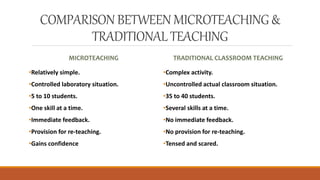Microteaching (1)
- 1. PRESENTATION ON MICROTEACHING SUBMITTED TO: MRS. LEHALI MADAM SUBJECT CO-ORDINATOR COMMUNICATION & EDUCATIONAL TECHNOLOGY COLLEGE OF NURSING, R.I.M.S SUBMITTED BY: AMBIKA MEHTA ROLL NO- 1 YUKTA GHOSH ROLL NO- 48 BASIC B. SC NURSING 2ND YEAR
- 2. OBJECTIVES The main objectives of microteaching are to: - Modify teacher’s behavior according to the specified objectives. Develop confidence in student- teachers with adequate motivation. Identify the deficiencies of student-teacher. Give immediate feedback to enable them to modify their teaching behavior.
- 3. CONTENTS Introduction Definition Characteristics Requirements of microteaching Phase Microteaching cycle Steps of microteaching Types of microteaching skills Principles underlying microteaching Advantages Disadvantages Duration of the microteaching in India Comparison between microteaching and traditional teaching Resources used Bibliography
- 4. INTRODUCTION Microteaching is one of the most recent innovations in teacher education program which aims to modify teachers behaviour according to the specified objectives. The history of microteaching dates back to 1961 when Keith Atchison, a doctor candidate at Stanford University, discovered the use of videotape-recorder for teaching interns in an innovation teacher education program.
- 5. DEFINITION “Microteaching is a scaled down teaching encounter in class size and period” D.W Allen (1966) According to definition: Microteaching is a teacher training programme in which student teachers enrich their teaching skills through practice teaching and scaling down the class size, duration of period, size of the topic under controlled conditions.
- 6. CHARaCTERiSTICS It is a scaled down teaching where the class size is 5 – 10 students, the class time is 5 – 10 minutes, the teaching skill is one at a time, the topic size is reduced. It provides immediate feedback to the student teacher for education. It is highly an individualized teacher training device.
- 8. PHASES According to J.C Clift, microteaching procedure has three phases: Knowledge acquisition phase. Skill acquisition phase. Transfer phase.
- 9. These phases are presented by N.K Jangira and Ajit Singh: Knowledge acquisition phase: the students teacher attempts to acquire knowledge about skill, its rationale and its role in classroom. Skill acquisition phase: in this phase, student teacher prepares a micro-lesson and practices skill and executes microteaching cycle. Transfer phase: in this phase, student teacher integrates different skill. It occurs in real setting that is classroom and integrates all skills.
- 10. PHASES
- 11. MICROTEACHING CYCLE •Planning the lesson. •Teaching the lesson. •Discussion/feedback. •Re-planning. •Re-teaching. •Re-discussion/re-feedback.
- 13. TEACHING: 6 minutes FEEDBACK: 6 minutes RE-PLANNING: 12 minutes RE-TEACHING: 6 minutes RE-FEEDBACK: 6 minutes TOTAL= 36 minutes DURATION OF MICRO- TEACHING IN INDIA
- 15. PREPARATION OF THE MICRO LESSON PLAN CRITICISM OF THE MODEL LESSON OBSERVATION OF THE MODEL LESSON PRESENTATION OF MODEL DEMONSTRATION-LESSON A PARTICULAR SKILL SELECTION OF PARTICULAR SKILL DISCUSSION OF TEACHING SKILLS ORIENTATION OF STUDENT TEACHER
- 16. INTEGRATION OF TEACHING SKILLS PROVIDING RE-FEEDBACK RE-TEACHING RE-PLANNING PROVIDING FEEDBACK PRACTICE OF SKILL CREATION OF MICROTEACHING SETTING
- 19. ADVANTAGES It helps the student teacher how to place a lesson in an efficient manner. It helps in developing self-confidence. The knowledge of practice and teaching skills can be given by the use of microteaching. It is an effective feedback device for the modification of teacher behaviour. The specific teaching skills are developed by the microteaching experiences. The training of teacher is more individualized.
- 20. ADVANTAGES CONTD. It can be done either in classroom or in simulated conditions. It is a simple procedure because each time a single skill is practiced. It is non-threatening and convenient to the beginners because the group is limited to 5 to 10.
- 21. DISADVANTAGES Microteaching takes place in simulated conditions. The behaviour of teachers in classroom may be different from simulated conditions. Recording using audio or video tape may be costly affair. It is time consuming training technique. Microteaching restricts to classroom technique only and is not applicable to other methods of teaching.
- 22. COMPARISON BETWEEN MICROTEACHING& TRADITIONALTEACHING MICROTEACHING •Relatively simple. •Controlled laboratory situation. •5 to 10 students. •One skill at a time. •Immediate feedback. •Provision for re-teaching. •Gains confidence TRADITIONAL CLASSROOM TEACHING •Complex activity. •Uncontrolled actual classroom situation. •35 to 40 students. •Several skills at a time. •No immediate feedback. •No provision for re-teaching. •Tensed and scared.
- 23. SUMMARY Microteaching is a teaching of one topic which should be taught within 5-10 minutes to 5-10 students. Teaching in short period of time to less number of students in simple and effective way, is microteaching. Microteaching has several advantages. It focuses on sharpening and developing specific teaching skills and eliminating errors. It enables understanding of behaviors important in classroom teaching. It increases the confidence of the learner teacher.
- 24. RESOURSES USED Consult with teacher. Communication & Educational Technology book. Internet.
- 25. BIBLIOGRAPHY SHEEBA K. TRYPHENA & PRASANNA M. LAKSHMI, TEXTBOOK OF COMMUNICATION & EDUCATIONAL TECHNOLOGY, 2ND EDITION, FRONTLINE PUBLICATIONS,PAGE NO 183-188. DR. SHARMA SURESH K. & SHARMA REENA, TEXTBOOK OF COMMUNICATION & EDUCATIONAL TECHNOLGY, 2ND EDITION, ELESVIER PUBLICATIONS, PAGE NO 258-262. www.slideshare.net FMT.pdf

























